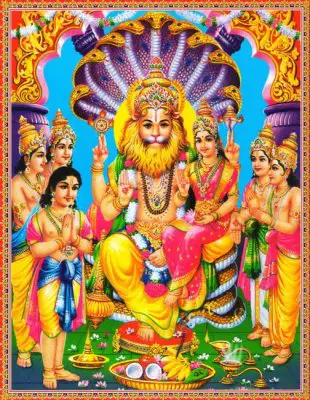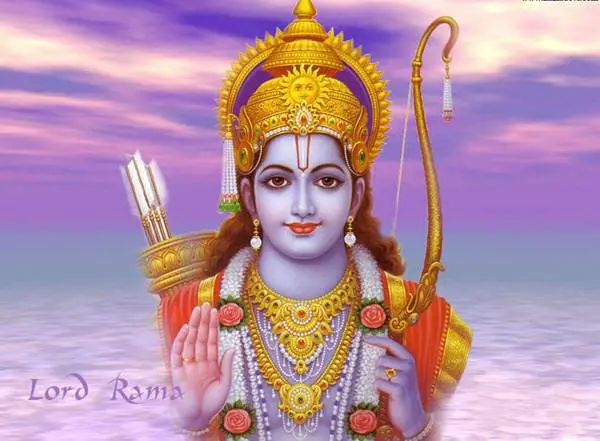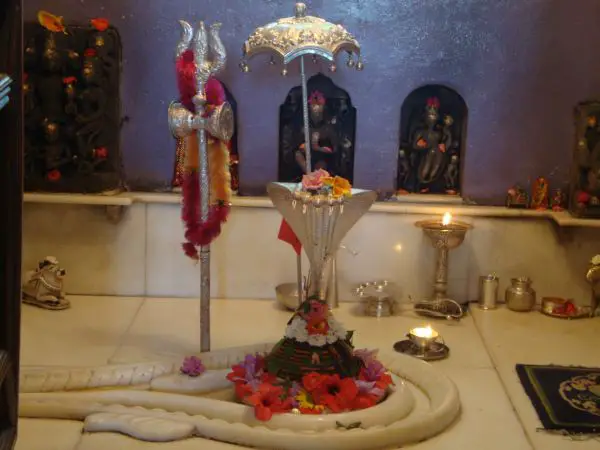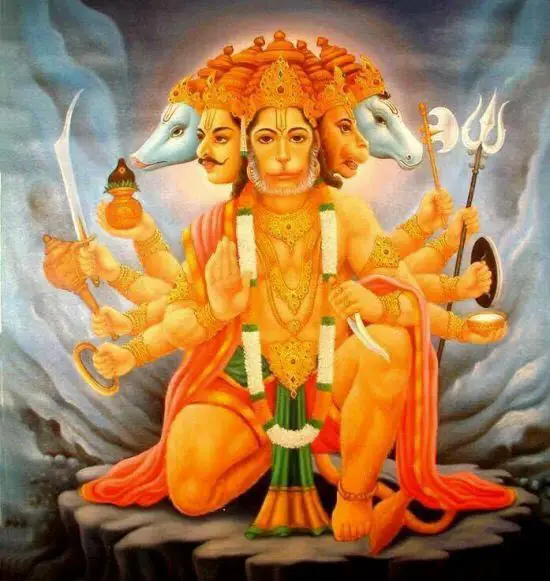The post shares with you the story of Lord Narasimha & Narasimha Jayanti. According to the Hindu scriptures, Lord Narasimha is described as a fierce avatar of the Hindu God Lord Vishnu.
Lord Narasimha incarnated in the form of part lion and part Man for destroying evil forces and ending calamity on Earth, thereby restoring the rule of Dharma and righteousness.

The word Narasimha consists of two words, namely “Nara” meaning man, and “Simha” meaning lion. Together the term “Narasimha” means “man-lion” and refers to a mixed creature avatar of Lord Vishnu.
Narasimha has been called by various names such as Narasingh, Narasimba, Nrusingha, and Narasingha. He is also known by other names such as:
- Agnilochana (अग्निलोचन) – the one with fiery eyes
- Bhairavadambara (भैरवडम्बर)- He is the one that causes terror by roaring
- Karala (कराल)- He is the one with a wide mouth and projecting teeth
- Hiranyakashipudvamsa (हिरण्यकशिपुध्वंस) – He is the one that killed Hiranyakashipu
- Nakhastra (नखास्त्र) – the one for whom nails are his weapons
- Sinhavadana (सिंहवदन) – the whose face is of a lion
- Mrigendra (मृगेन्द्र) – king of animals or lion
Narasimha’s iconography depicts him with a human torso and lower body. He has a lion face and claws. He holds the demon Hiranyakashipu in his lap, whom he is about to kill.
The demon Hiranyakashipu was the powerful brother of evil Hiranyaksha, who was previously killed by Lord Vishnu. Hiranyakashipu had got special powers, and he could neither be killed during the day or night, inside or outside, by any weapon nor by any man or animal.
Endowed with these special powers, Hiranyakashipu went on to create chaos all around. He persecuted all devotees of Lord Vishnu and even harassed and tormented his son, Prahlad.
Lord Vishnu understood the demon’s powers and creatively adopted himself in the form of a mixed avatar that is neither man nor animal as Narasimha, who killed the demon at the junction of day and night, inside and outside.
So, Narasimha turns out to be a “Great Protector” who protected his devotees from evil. He overwhelmed and killed Prahlad’s demonic father and tyrant, Hiranyakashipu.
Narasimha has been treated as a popular deity in the Vaishnava traditions of the Hindu religion. Many Hindu temples, texts, and festivals have been dedicated to Lord Narasimha. He is celebrated in many Hindu festivals such as Holika, which falls before the colorful festival of Holi.
Many artworks have been dedicated to Lord Narasimha. The oldest known artworks of Narasimha have been found at several places across Uttar Pradesh as well as Andra Pradesh, including the Mathura archeological site.
Even the Rig Veda contains a verse (Vishnu hymn 1.154) such as “wild beast, dread, prowling, and mountain-roaming” that has been interpreted as a Narasimha legend.
There are also references to Narasimha Avatar in a variety of Puranas including the Valmiki Ramayan, Bhagavata Purana, Agni Purana, Vayu Purana, Kurma Purana, Matsya Purana, Skanda Purana, and many others.
Table of Contents
Story of Lord Narasimha
Lord Vishnu took the incarnation of Narasimha in his fourth incarnation. His previous incarnation was in the form of Varaha (Boar), who killed the demon Hiranyaksha.
Hiranyaksha’s brother Hiranyakashipu was very upset by the killing of his brother by Lord Vishnu. He wanted to take revenge by killing Lord Vishnu and his followers.
So, he performed deep penance to please Lord Brahma, the God of Creation. Lord Brahma was impressed by his act and said to Hiranyakashipu that he could ask for any boon.
Hiranyakashipu asked for a tricky boon that he neither could be killed on earth or in space, by man, animal, or God; neither during the day nor at night, nor in fire or water, neither inside nor outside of the home; neither inanimate nor animate being.
Lord Brahma granted this boon to Hiranyakashipu.
Now, Hiranyakashipu had no fear of death. He unleashed terror and declared himself as a God. He ordered his people not to utter any name of God except his.
However, his son, Prahlad, was a devotee of Lord Vishnu and refused to follow his orders. Hiranyakashipu tried to persecute him but with no result. Prahlad declared that Lord Vishnu is omnipresent.
Once Hiranyakashipu pointed to a pillar and asked Prahlad if Vishnu is present in it. Prahlad nodded in affirmation. Angered by his son’s reply, Hiranyakashipu draws out his sword and cuts the pillar. Lord Narasimha appeared out of this broken pillar.
Narasimha was the man-lion form of Lord Vishnu. He killed Hiranyakashipu at the twilit (neither day nor night); on the doorsteps of his palace (which is neither inside nor outside of the home); puts him on his lap (neither on earth nor in space); and used his nails for killing (neither animate nor inanimate).
So, Lord Narasimha made the power of the boon ineffective and killed Hiranyakashipu. The death of Hiranyakashipu is celebrated in India during the festival of Holi, especially in the northern region.
How did Narasimha killed Hiranyakashipu?
Hiranyakashipu was very upset and angry at his son Prahlad’s devotion to Lord Vishnu. Hiranyakashipu regarded Vishnu as his mortal enemy. So, he decided to kill his son Prahlad.
However, all his attempts got failed as Prahlad was protected by Vishnu’s mystical powers. Prahlad refused to accept Hiranyakashipu as the supreme Lord of the Universe and declared that Lord Vishnu is all-pervading and omnipresent.
Once Hiranyakashipu pointed to a nearby pillar and asked Prahlad if Vishnu is present in it. To this, Prahlad replied that He was, He is, and He will be. Hiranyakashipu went furious to hear this reply from Prahlad. He was immensely angry at Prahlad and smashed the pillar with his mace.
A tumultuous sound came out of the pillar, and Lord Vishnu appeared in the form of Narasimha from the broken pillar. Narasimha moved to attack Hiranyakashipu in defense of Prahlad. Lord Vishnu took the incarnation of Narasimha to kill Hiranyakashipu without violating the boon given by Brahma.
According to the boon, Hiranyakashipu cannot be killed by humans, deva, or animals. However, Narasimha is none of these as He is the incarnation of Vishnu as part human and part animal.
Narasimha attacked Hiranyakashipu at twilight, which is neither day nor night. He attacked Hiranyakashipu on the threshold of a courtyard, which is neither indoors nor out.
He put the demon on his thighs, which is neither earth nor space. He used his nails (neither animate nor inanimate) as weapons to disembowel and kill Hiranyakashipu.
Who killed Lord Narasimha?
Once Lord Narasimha tore away, the demon Hiranyakashipu into pieces, He went wild in anger, and his temper could not be subsided. He took a terrible form and moved everywhere with red eyes. Moreover, he assumed terrible forms such as that of Kandaberunda, which is a very rare two-headed bird incarnation.
All the three worlds trembled in fear to see this form of Lord Narasimha. All the Gods became scared and approached Lord Shiva for a solution. They prayed to Lord Shiva and requested him to intervene in the scene.
So, Lord Shiva sent his lieutenant Veerabadhra to pacify Lord Narasimha. However, this went in vain as Veerabadhra could do little even to approach Narasimha. Veerabadhra came back to Lord Shiva and requested Him to do something personally.
What Lord Shiva did for counteracting the anger of Narasimha has been mentioned in the Sarabha Upanishad of Atharva Veda.
Lord Shiva assumed the form of Sarabeshwara (It was a combination of man, eagle, and lion) to end the havoc created by Narasimha.
Sarabeshwara was the thirtieth manifestation of Lord Shiva among his sixty-four incarnations that He took in total.
Sarabeshwara sported two massive wings. He possessed eight legs, and the nose of an eagle. His four arms held fire, deer, ankus, and serpent. He had sharp nails like a thunderbolt.
This fearful and terrible form of Sarabeshwara came flying in the cosmos and landed itself near Lord Narasimha.
He flapped its wings to give comfort and cool down Lord Narasimha. However, Lord Narasimha could not be controlled, and He assumed the form of Kandaberunda and started warring with Sarabeshwara. This divine war lasted for eighteen days.
Now, Sarabeshwara decided to end this sport. So, he released Pratyinkira Devi from his wings which devoured the Kandaberunda bird. Narasimha realized his erroneous action and pleaded pardon from Lord Shiva. This action of Narasimha pleased Lord Shiva, and he then comforted Lord Narasimha.
Narasimha and Brahma sang praises for Sarabeshwara several times, which have become holy chants. Now, Sarabeshwara declared that he manifested to appease the anger of Narasimha. However, the two are the same water and water, milk and milk, and ghee and ghee. So, they are inseparable and should be worshipped together.
Lord Narasimha Temples
Lord Narasimha (half lion and half man) was the fourth incarnation of Lord Vishnu. Here, we share with you the most famous Lord Narasimha temples in India.

- Yadagirigutta Narasimha Temple in Telangana: This Lakshmi Narasimha Temple at Yadagirigutta is one of the most famous historic temples of Lord Narasimha in India.
- Ahobilam Narasimha Swami Temple in Andhra Pradesh: This beautiful and historic temple is located at Allagadda which is a very beautiful place near Kurnool
- Melkote Yoga Narasimha Temple in Karnataka: This beautiful and historic temple is located in Melukote taluk, which is regarded as a sacred place in Karnataka.
- Shri Laxmi Narasimha Temple in Maharashtra: This temple of Laxmi Narasimha is located at the confluence of Bhima and Nira Rivers in the Pune district.
- Yogananda Narasimha Temple in Telangana: This temple of Narasimha has been located at Bhadrachalam on the way to the main Ramachandra Swamy temple from the riverbank
- Lakshmi Narasimha Temple in Kerala: It is one of the most popular temples of Lord Narasimha in Kerala. This temple is located in Kannur in the heart of Thalassery town.
- Narsinghji Narasimha Temple in Rajasthan: This temple of Lord Narasimha is located at Hindaun in Rajasthan and is 15 km far from the Hindaun City
- Simhachalam Narasimha Temple in Andhra Pradesh: It is one of the most famous Narasimha temples in Andra Pradesh. It is regarded as an important center of Vaishnavism in India.
Narasimha Jayanti
The Vaishakha Shukla Chaturdashi Tithi has been celebrated in the form of Narasimha Jayanti. Lord Narasimha is regarded as the fourth incarnation of Lord Vishnu. It was on the day of Narasimha Jayanti that Lord Vishnu took the form of Narasimha (half lion and half man) for killing the demon Hiranyakashipu.
The Vaishakha Shukla Chaturdashi, in combination with Swati Nakshatra and weekday Saturday, is considered highly auspicious for observing Narasimha Jayanti Vratam. Devotees observe a fast on this day and worship Lord Vishnu.
The rules and guidelines for observing Narasimha Jayanti Vratam are similar to those of Ekadashi Vratam. Devotees take the only signal before one day on Narasimha Jayanti. The eating of grains and cereals has been prohibited on Narasimha Jayanti Vratam. Parana, which is the breaking of the fast is done the next day following Narasimha Jayanti at the most appropriate timing.
On the day of Narasimha Jayanti, devotees take Sankalp during the afternoon period at Madhyahna. They also perform Lord Narasimha Pujan in the Sayankal before sunset. It is believed that Lord Narasimha appeared at the sunset when Chaturdashi was prevailing. Devotees keep night vigil and perform Visarjan Puja the next day following Narasimha Jayanti. The fast is also broken the next day after doing Visarjan Puja and giving donations or Dana to Brahmins.
Narasimha Jayanti Date 2024
Narasimha Jayanti will be celebrated on 21st May 2024, Tuesday. The Narasimha Jayanti Sayana Kala Puja Timing prevails from 04:24 PM to 07:09 PM.
The Narasimha Jayanti Madhyahna Sankalp Timing is between 10:56 AM to 01:40 PM.
Chaturdashi Tithi Begins: 05:39 PM on 21st May 2024
Chaturdashi Tithi Ends: 06:47 PM on 22nd May 2024
With this, we have come to the end of this post on Lord Narasimha and Narasimha Jayanti. We believe that you found the post useful and interesting. Thanks for visiting. We welcome your comments and suggestions.




